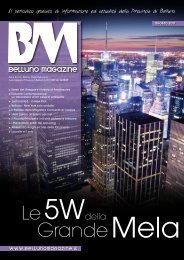Settembre 2010 - Belluno Magazine
Settembre 2010 - Belluno Magazine
Settembre 2010 - Belluno Magazine
You also want an ePaper? Increase the reach of your titles
YUMPU automatically turns print PDFs into web optimized ePapers that Google loves.
english?yes, please!<br />
<strong>Belluno</strong> <strong>Magazine</strong> il periodico gratuito di informazione ed attualità della Provincia di <strong>Belluno</strong><br />
24<br />
Fascinating<br />
Japan part<br />
di Nick Simcock<br />
nick@nicksimcock.com<br />
This year my wife and I went to Japan with<br />
a group of seven friends. Our two week tour<br />
included Tokyo, Hiroshima and its bay, Kyoto,<br />
the area around Mount Fuji and various<br />
temples.<br />
Although we prepared well for the experience by reading guide<br />
books we were still surprised and amazed by the people and<br />
places of this fascinating country.<br />
The Japanese look different<br />
If you are used to living in the west, just walking<br />
among the people of Japan is fascinating. It’s not<br />
just their eye shape and skin colour that make<br />
them look different, but also their physical build.<br />
Human curiosity however is universal and I<br />
was very surprised when a Japanese girl asked if<br />
she could take a photograph of me. She said with<br />
a smile in broken English, “you have such small<br />
head, Japanese men have very big head!”<br />
The clothes<br />
The traditional Kimono http://en.wikipedia.org/<br />
wiki/Kimono must be the most famous Japanese<br />
garment. For me the beauty is in the overall shape<br />
and the small details. The sight of a Japanese man<br />
or lady dressed in this way on a modern city street<br />
or on a train is quite unique.<br />
To the other extreme are the teenage girls who<br />
model their style somewhere between Paris Hilton,<br />
Madonna (from the 80’s) and Gwen Stefani. A<br />
trip to the Shibuya109 shopping centre in Tokyo<br />
where teenagers buy their clothes is a truly colourful<br />
experience!<br />
http://en.wikipedia.org/wiki/Shibuya,_Tokyo<br />
The Japanese are very polite, respectful,<br />
effi cient and punctual<br />
We saw amazing examples of all these Japanese<br />
characteristics at Shinagawa Station in Tokyo<br />
when we caught the Shinkansen or Bullet train.<br />
All passengers must wait in orderly queues on<br />
the platform within colourful lines painted onto<br />
the fl oor. Also shown at the edge of the platform<br />
is the number of the train carriage, and yes it<br />
stops at precisely that point! As our train arrived,<br />
smartly uniformed cleaners appeared along the<br />
edge of the platform. When the train doors ope-<br />
1<br />
Nick Simcock è nato a Stoke<br />
on Trent in Inghilterra nel<br />
1971. Vive e lavora a <strong>Belluno</strong><br />
dal 2002. I suoi programmi<br />
radiofonici “The English<br />
lesson” e “Good afternoon”<br />
si possono ascoltare sulle<br />
frequenze di Radio <strong>Belluno</strong><br />
www.radiobelluno.it<br />
Il suo sito personale è www.nicksimcock.com<br />
ned we continued to wait as the<br />
cleaners entered the carriages with<br />
a military precision. After about two<br />
minutes they all exited the train at<br />
exactly the same time and stood to<br />
attention by the door. Then each<br />
cleaner gave a bow to the fi rst passenger<br />
boarding the train and thanked<br />
him for giving him a job to do!<br />
This bowing and level of respect is<br />
very common and accompanies all<br />
Japanese social interactions. The<br />
trains illustrate another<br />
important aspect of Japanese<br />
life, punctuality. When<br />
the train is scheduled to leave at<br />
13.03 it leaves at 13.03! Whatever<br />
you do don’t be late for anything in<br />
Japan, it is a sign of gross disrespect.<br />
Talking of respect, if you are noisy<br />
by nature (or simply Italian!) then<br />
you must remind yourself to lower<br />
your volume! The Japanese are generally<br />
very quite. They also work<br />
very long hours and the train and<br />
the metro seem to offer a welcome<br />
opportunity to sleep.<br />
The Japanese language<br />
Apart from a few essential words<br />
like “arigato” (meaning thank you)<br />
the Japanese language is very different<br />
from ours. It’s not just the<br />
words and pronunciation, but also<br />
the structure, tonality and overall<br />
musicality that is very different. I<br />
had presumed (like a classic Brit’)<br />
that English would be the way to<br />
communicate, and while this was<br />
true in big hotels and some large shops,<br />
there were other moments when even<br />
hand gestures were useless! Fortunately<br />
we had a Japanese speaker in our group<br />
and without her it would have been quite<br />
a challenge at times. Just to learn the<br />
numeric system would take a huge effort<br />
as the words for their numbers change<br />
depending on what you are talking about.<br />
Another element in the communication<br />
problem comes from their culture. The<br />
Japanese will never use the word “no”<br />
when they reply to a question, because<br />
it would sound disrespectful. At times in<br />
restaurants or shops it is impossible to<br />
understand whether the answer to your<br />
question is yes or no. Even after speaking<br />
to our Japanese friend about this cultural<br />
difference I still fail to understand how<br />
this system works - try taking “no” out<br />
of your vocabulary even for fi ve minutes<br />
and you will see what I mean!<br />
Japan is a culinary adventure (as long as<br />
you like fi sh!)<br />
Most restaurants in Japan present their<br />
menus in the window as photos or perfectly<br />
waxed versions of the real thing.<br />
Mediabelluno Srl<br />
CERCA<br />
COLLABORATORI<br />
When the dish arrives it is amazing to<br />
compare it to the photo or the wax model<br />
as they are identical! Not knowing<br />
the language means you end up choosing<br />
your restaurant based on the quality of<br />
the photos in the window. It was impossible<br />
to know exactly what we were ordering.<br />
Other than rice or noodles there<br />
were numerous ingredients impossible<br />
to identify. The main ingredient is fi sh,<br />
but chicken and beef were also common.<br />
There were things fl oating in bowls or<br />
covered in sauce, things on sticks and<br />
stuff on rice and most of it was wonderfully<br />
tasty!<br />
In some restaurants they even leave you<br />
to do the cooking and in the middle of<br />
the table you fi nd a boiling broth or a grill<br />
with which to cook your fi sh or meat. The<br />
general rule with eating utensils is that<br />
you have to learn how to use chopsticks,<br />
although other members of our group<br />
managed to get a fork with the help of<br />
our translator.<br />
There is another important aspect if you<br />
are at all concerned about the natural environment.<br />
You should be aware that in<br />
Japan you can end up eating endangered<br />
per la vendita di spazi pubblicitari<br />
per le zone di Feltre, Fiera di Primiero,<br />
Cortina D’Ampezzo e tutto il Cadore.<br />
Se sei interessato invia una mail a<br />
info@bellunomagazine.it oppure chiama il 347 6773331.<br />
species of fi sh without realising. Red Tuna<br />
Sushi sure are tasty, but we only realised<br />
afterwards what we had eaten. Currently<br />
WWF say Red Tuna stocks are dangerously<br />
low and to avoid eating it, however<br />
the Japanese seem completely oblivious.<br />
You can smoke in bars or restaurants, but<br />
not on the street!<br />
Here in Italy and the UK even many smokers<br />
would agree that the smoking ban<br />
in bars and restaurants is a good thing.<br />
The health risks of passive smoking are<br />
obvious and it has become common to<br />
see groups of smokers outside. In Japan it<br />
is the exact opposite! Smoking is not<br />
permitted anywhere outside, if<br />
not for the designated smoking<br />
areas, and yet it is allowed in bars<br />
and restaurants. The interesting thing<br />
is that the Japanese seem to be more<br />
concerned in keeping Japan clean than<br />
keeping it healthy. The no smoking signs<br />
illustrate how much mess a discarded cigarette<br />
can cause and don’t even mention<br />
that smoking can kill you! This in a country<br />
where many people choose to wear<br />
medical face masks in public for fear of<br />
becoming ill. Yet another example of the<br />
many strange contradictions in this fascinating<br />
country.<br />
Next time in part 2 I will write about<br />
beautiful Shinto and Buddhist temples,<br />
Zen gardens and rice fi elds, karaoke, hot<br />
baths, technology, manga and more about<br />
the fascinating people of Japan! •<br />
Il periodico gratuito di informazione<br />
ed attualità della Provincia di <strong>Belluno</strong><br />
> english?yes, please!<br />
<strong>Belluno</strong> <strong>Magazine</strong> il periodico gratuito di informazione ed attualità della Provincia di <strong>Belluno</strong><br />
25







